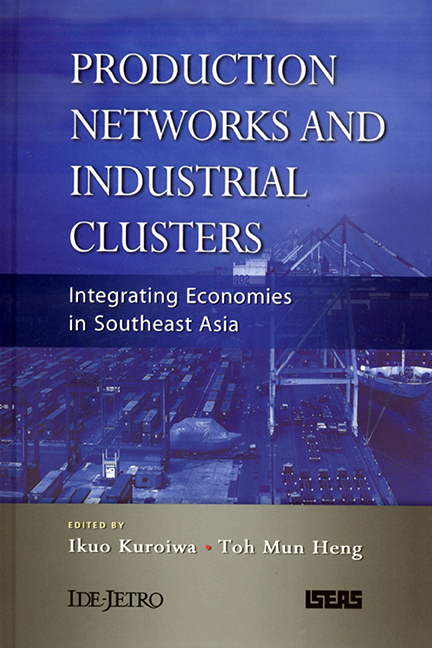Book contents
- Frontmatter
- Contents
- List of Tables
- List of Figures
- Preface
- Acknowledgements
- Contributors
- 1 Introduction
- I Overview of the Production Networks and Industrial Clusters in Southeast Asia
- II Case Studies
- III Drivers for the Expanding Production Networks
- 8 Supply Chain Management and Logistics in Southeast Asia
- 9 Regional Economic Cooperation and Production Networks in Southeast Asia
- 10 Concluding Remarks: Implications for Public Policy
- Index
8 - Supply Chain Management and Logistics in Southeast Asia
from III - Drivers for the Expanding Production Networks
Published online by Cambridge University Press: 21 October 2015
- Frontmatter
- Contents
- List of Tables
- List of Figures
- Preface
- Acknowledgements
- Contributors
- 1 Introduction
- I Overview of the Production Networks and Industrial Clusters in Southeast Asia
- II Case Studies
- III Drivers for the Expanding Production Networks
- 8 Supply Chain Management and Logistics in Southeast Asia
- 9 Regional Economic Cooperation and Production Networks in Southeast Asia
- 10 Concluding Remarks: Implications for Public Policy
- Index
Summary
INTRODUCTION
International trade in services is becoming more and more important. In this paper, we focus on supply chain and logistics services in Southeast Asia. The supply chain concept is an extension of Michael Porter's Value Chain Analysis that involves external entities linked to the production of a product. Nike is a good case in point. Their shoes are made in China but designed in the United States. From design to production, we are witnessing a production process in which the following characteristics are observed:
• Production blocks are centres of activities — centres which can produce a particular stage efficiently and effectively. If all activities could be produced in one entity, we then have only one production block. However, specialisation and differences in factor prices result in many production blocks.
• Service links are bundles of activities that serve to coordinate and link production blocks. More and more of these service links activities are undertaken by entities in various countries and cross border coordination is crucial and necessary. SCM and logistics are part of these service links activities.
• Each node in the supply chain engages in a value-added process.
With this as a backdrop, we will discuss supply chain management (SCM) and logistics in Southeast Asia, starting with a few definitions.
Definitions and Scope
SCM (sometimes called logistics management) refers to the management and control of the flow of inventory, information and other resources (e.g., services, money, equipment, people) across the supply chain with the purpose to satisfy customer requirements. In essence, SCM deals with the geographical repositioning of raw materials, work-in-process, finished, and returned inventories in a cost efficient manner. To facilitate smooth flow between point-of-origin to point-of-consumption, SCM requires an integrated, cross-functional approach, and trust and collaboration among the supply chain partners to provide inventory visibility and inventory velocity. The term SCM was coined by consultant Keith Oliver of strategy consulting firm Booz Allen Hamilton in 1982.
- Type
- Chapter
- Information
- Production Networks and Industrial ClustersIntegrating Economies in Southeast Asia, pp. 259 - 300Publisher: ISEAS–Yusof Ishak InstitutePrint publication year: 2008



